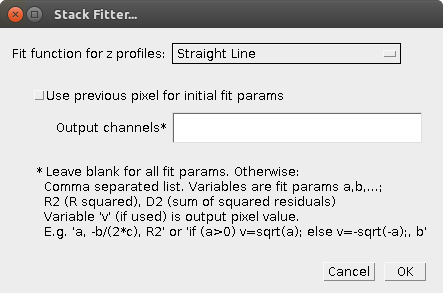plugin:stack:stack_fitter:start
Table of Contents
Stack Fitter
This plugin fits the data along the z axis (as obtained with Image>Stacks>Plot z axis profile) for each (x,y) pixel of a stack and creates a new stack with the fit results.
- Supports the built-in ImageJ fit functions (you have modify the code for your own functions).
- Input data are calibrated pixel values (if there is a calibration), also the z axis calibration is taken into account.
- The output is a stack of fit parameters, functions thereof, and/or data on the quality of the fit for each (x,y) pixel.
- Hyperstacks are not supported.
Dialog Options
Fit function for z profiles
- Selects the function, see the ImageJ documentation.
Use previous pixel for initial fit params
- This should be selected if adjacent pixels (or all pixels) typically have similar z profiles. Then the initial “guess” parameters are taken from the result of the previous pixel.
- When unchecked, ImageJ tries to guess the initial parameter form the data values of each curve.
- This option has no effect for fits using linear regression only (“Straight Line” and everything with “linear regression” in the name).
Output channels
- Here you can specify the slices of the output stack with a comma-separated list.
- When blank, there is one slice for each fit parameter.
- Otherwise, you can specify which parameter(s) or numbers the slices correspond to:
- Variables
a, b, c,… are the fit parameters. R2is the R squared value, the coefficient of determination.D2is the sum of squared residuals.- You can also make functions from these; use
vto specify the function result.
- Example:
a, -b/(2*c), R2'- Here, the first output stack slice is the 'a' parameter,
- the second slice is calculated from the 'b' and 'c' parameters as
-b/(2*c), and - the third slice is Rsquared,
- Example:
if (a>0) v=sqrt(a); else v=-sqrt(-a);, b- Here, the first output stack slice is the square root of the 'a' parameter, or minus the square root of -a, if a is negative, and
- the second slice gets the fit parameter 'b' as pixel values.
Performance
Fitting a 512*512*10 stack with 'Exponential with Offset' needs about a minute on a core i7-6700 (this fit has effectively only one parameter, the two other parameters are calculated directly via linear regression). There is no parallelization except for the parallelization of the ImageJ Minimizer, which uses two threads in parallel to search for minima.
Installation
- Copy Stack_Fitter.java into the ImageJ/plugins folder or a subfolder thereof (not a sub-sub-folder or deeper). Make sure that you name the downloaded file ”Stack_Fitter.java”; uppercase/lowercase matters. Then use Compile&Run.
- Alternatively, download Stack_Fitter.class and save it under ImageJ/plugins or a subfolder thereof with exactly this name. Then restart ImageJ or use Help>Update Menus.
Version History
- 2018-03-23 First version uploaded (Michael Schmid)
plugin/stack/stack_fitter/start.txt · Last modified: 2019/04/12 13:13 by 127.0.0.1

